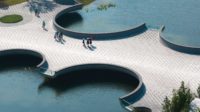| Image courtesy Höweler + Yoon |
The new center will occupy a roughly 17,000-square-foot, two-story space in a new waterfront tower. |
In an effort to provide more services for its members and create a stronger public presence, the Boston Society of Architects (BSA) plans to move to a bigger, more visible spot this November. And after launching a competition to engage emerging architects and solicit the best ideas for the new center, the BSA has selected Höweler + Yoon Architecture’s attention-grabbing design.
The new center will occupy a roughly 17,000-square-foot, two-story space the BSA is renting in a new waterfront tower. The iconic element of Höweler + Yoon’s proposal, titled Slipstream Public Exchange, is a green steel stairway that extends from the ground level up a wall and onto the ceiling of the second floor, and incorporates an LED sign band that broadcasts information. “It was the consolidation of moves into one gesture,” says Eric Höweler, principal of the Boston-based firm with J. Meejin Yoon.

Conference rooms are housed in pods inside the gallery space on the second level. In addition to serving as an exhibition and meeting area, the architects also suggest that the gallery be an extension of the BSA’s website and offer interactive, digital resources.
Having outgrown its 5,000-square-foot location in the financial district, the BSA – the largest AIA chapter with 5,000 members – is moving to the Atlantic Wharf high-rise, located on the corner of Congress Street and Atlantic Avenue in the emerging, post-industrial Fort Point Channel. It’s a locale that will allow the 1867 institution to benefit from proximity to restaurants, shops, and public transportation, and, perhaps most importantly, foot traffic, says Audrey O’Hagan, president of the BSA.
The BSA’s current venue is not visible from the street and doesn’t allow for much interaction. “That is really in contrast to the BSA’s core values – openness and inclusivity,” says O’Hagan. “We thought the new location should provide the BSA with more connectivity to people who happen to be walking past and may be drawn in unexpectedly.” Höweler + Yoon’s scheme, chosen in January, impressed the competition jury with its understanding of that need, says O’Hagan.
“Hopefully they’ll get a new audience,” says Höweler. “It’s a big shift for them, to something a little edgier.” The new headquarters will also help promote architecture culture in Boston, where there are architecture schools but no “neutral ground,” he says, referring to New York City’s design venues such as Storefront for Art and Architecture, The Architectural League, and the AIA Center for Architecture.
Nineteen firms submitted a proposal for the BSA competition. The shortlist included Merge Architects, Inc., Single Speed Design, Abacus Architects + Planners, and Hashim Sarkis Studios.










Post a comment to this article
Report Abusive Comment